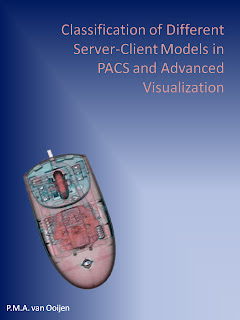This blog provides information on conferences and novelties in the area of Medical Imaging Informatics (MII). MII has a broad scope ranging from the Radiology Information System and Picture Archiving and Communication System (PACS) to Advanced Visualization and Computer Aided Diagnosis (CAD). To find new opportunities in healthcare we need to look at informatics solutions in other areas to apply them into the medical field to achieve higher level healthcare at lower costs.
Wednesday, December 19, 2012
NEW! IHE Radiology White Papers Published
Tuesday, December 18, 2012
New on this blog! Whitepapers as e-books
The first whitepaper is on "Classification of Different Server-Client Models in PACS and Advanced Visualization".
Thursday, December 13, 2012
Cybercriminals Hold Australian Medical Clinic Electronic Patient Records Hostage
Go here for an ABC news TV item, click below to read the story on the IEEE Spectrum website.
Cybercriminals Hold Australian Medical Clinic Electronic Patient Records Hostage
Wednesday, December 12, 2012
RSNA 2012 - IHE Image Sharing Demonstration
IHE Image Sharing Demonstration
PURPOSE/AIM
The IHE Image Sharing Demonstration will showcase developments in radiology informatics, standards-based interoperability and image sharing. The demonstration will include: Exchange The IHE Image Sharing Demonstration will showcase developments in radiology informatics, standards-based interoperability and image sharing. The demonstration will include: Exchange of medical images and reports using personal health record (PHR) accounts as in the RSNA Image Share pilot project, funded by the National Institute of Biomedical Imaging and Bioengineering (NIBIB). The image exchange architecture is based on the IHE Cross-enterprise Document Sharing for Imaging (XDS-I) profile.Patient radiation dose monitoring in local and national settings based on DICOM Dose Structure Reports (SRs) and the IHE Radiation Exposure Monitoring (REM) profile.Ordering and scheduling of radiology procedures using procedure names from the RSNA RadLex Playbook.Generation of radiology diagnostic reports using structured templates developed by the RSNA Reporting Committee and including RadLex terminology.Exporting image data exported from PACS using the IHE Teaching File and Clinical Trial Export (TCE) profile and using this data to author teaching files and processing of images for clinical trials using the RSNA MIRC software.
Tuesday, December 4, 2012
CMInen 2012 Event
Prof. Klink, former Minister of Health, gave a presentation on Why the healthcare system is obstructing innovation and how it can be restored. More and more diagnosis is possible in screening, however, the effects on mortality are marginal. Therefore, anxiety for patients and costs for (unnecessary) treatment are the result. This way of working is advocated by the current healthcare system. However, getting more precision in the diagnosis will decrease the over diagnosis and treatment and reduce the negative effects of current screening. Technological innovation is required to achieve this increase in precision in the diagnosis. However, promising areas for technological break are available but innovations often fail to break through in oud health care system. One of the problems is the fragmentation of healthcare, which hampers investment into innovations. Not only price of treatment should be the focus of research but also the decrease of volume since that is one of the major drivers behind the cost increase in healthcare.
Mr. van Schaik, director healthcare Rabobank, discussed Innovation in high technology health care environments in the perspective of the financial sector. In 2010 a book was published on diagnose 2025 to start the discussion on where the health sector would end up. This resulted in 17 trends in healtcare such as for example individualism, prevention, power to the patient, healthy ageing. The most important drivers for healthcare are the macro economy and politics. In 2010 they concluded at the healthcare system was not sustainable and needed disruptive changes in which technological innovations have to play an important role. Currently, this is further explored in a new initiative called diagnosis technology. This new initiative should provide insight in how and where technology can be used to improve healthcare. Currently we are at a point of a paradigm shift in healthcare from more cost reduction centric to innovation and patient centric.



